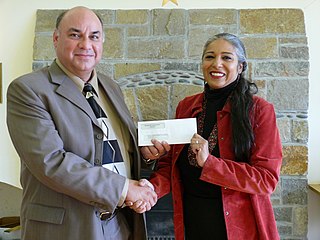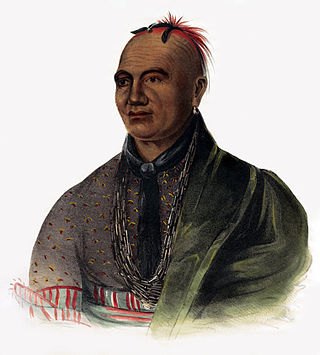Related Research Articles

The Mohicans are an Eastern Algonquian Native American tribe that historically spoke an Algonquian language. As part of the Eastern Algonquian family of tribes, they are related to the neighboring Lenape, whose indigenous territory was to the south as far as the Atlantic coast. The Mohican lived in the upper tidal Hudson River Valley, including the confluence of the Mohawk River and into western New England centered on the upper Housatonic River watershed. After 1680, due to conflicts with the powerful Mohawk to the west during the Beaver Wars, many were driven southeastward across the present-day Massachusetts western border and the Taconic Mountains to Berkshire County around Stockbridge, Massachusetts.

Tammany Hall, also known as the Society of St. Tammany, the Sons of St. Tammany, or the Columbian Order, was an American political organization founded in 1786 and incorporated on May 12, 1789, as the Tammany Society. It became the main local political machine of the Democratic Party and played a major role in controlling New York City and New York State politics, and helped immigrants, most notably the Irish, rise in American politics into the 1960s. Tammany typically controlled Democratic nominations and political patronage in Manhattan after the mayoral victory of Fernando Wood in 1854, and used its patronage resources to build a loyal, well-rewarded core of district and precinct leaders; after 1850 the vast majority were Irish Catholics due to mass immigration from Ireland during and after the Irish Famine.

The Lenape, also called the Lenni Lenape and Delaware people, are an indigenous people of the Northeastern Woodlands, who live in the United States and Canada.

The Wampanoag, also rendered Wôpanâak, are a Native American people of the Northeastern Woodlands based in southeastern Massachusetts and historically parts of eastern Rhode Island, Their territory historically includes the islands of Martha's Vineyard and Nantucket.

The Improved Order of Red Men is a fraternal organization established in North America in 1834. It claims direct descent from the colonial era Sons of Liberty. Their rituals and regalia are modeled after those assumed by men of the era to be used by Native Americans. Despite the name, the order was formed solely by, and for, white men. This whites-only rule was part of their bylaws until 1974, when the all-white clause was eliminated. Their current position is that they are now open to people of all ethnic backgrounds. In 1935 the organization claimed a membership of about half a million, but it has now declined to a little more than 15,000.
The Seneca are a group of Indigenous Iroquoian-speaking people who historically lived south of Lake Ontario, one of the five Great Lakes in North America. Their nation was the farthest to the west within the Six Nations or Iroquois League (Haudenosaunee) in New York before the American Revolution.

The Shawnee are an Indigenous people of the Northeastern Woodlands. Their language, Shawnee is an Algonquian language.

Lord Dunmore's War, also known as Dunmore's War, was a brief conflict in fall 1774 between the British Colony of Virginia and the Shawnee and Mingo in the trans-Appalachian region of the colony south of the Ohio River. Broadly, the war included events between May and October 1774. The governor of Virginia during the conflict was John Murray, 4th Earl of Dunmore, who in May 1774, asked the House of Burgesses to declare a state of war with the Indians and call out the Virginia militia.

The Order of Angell, known for decades as Michigamua, was a senior honorary society recognizing student leaders and outstanding athletes at the University of Michigan. For most of its history, its practices reflected images of Native Americans drawn from Euro-American popular culture. From Michigamua's founding in 1901 until the 1970s, membership was a badge of distinction. From the 1970s on, the society drew rising criticism for admitting only men; for the form of cultural appropriation known as "playing Indian;" and for possessing Native American artifacts.
Wampage I, also called Anhōōke and later John White, was a Sagamore of the Siwanoy Native Americans, who resided in the area now known as the Bronx and Westchester County, New York. He was involved in the murder of Anne Hutchinson and her fellow colonists in 1643.

Tamanend was the Chief of Chiefs and Chief of the Turtle Clan of the Lenni-Lenape nation in the Delaware Valley signing the peace treaty with William Penn.
The Siwanoy were an Indigenous American band of Munsee-speaking people, who lived in Long Island Sound along the coasts of what are now The Bronx, Westchester County, New York, and Fairfield County, Connecticut. They were one of the western bands of the Wappinger Confederacy. By 1640, their territory (Wykagyl) extended from Hell Gate to Norwalk, Connecticut, and as far inland as White Plains; it became hotly contested between Dutch and English colonial interests.

Ninigret was a sachem of the eastern Niantic Indian tribe in New England at the time of colonization, based in Rhode Island. In 1637, he allied with the colonists and the Narragansetts against the Pequot Indians.

Indigenous peoples of the Northeastern Woodlands include Native American tribes and First Nation bands residing in or originating from a cultural area encompassing the northeastern and Midwest United States and southeastern Canada. It is part of a broader grouping known as the Eastern Woodlands. The Northeastern Woodlands is divided into three major areas: the Coastal, Saint Lawrence Lowlands, and Great Lakes-Riverine zones.

Sachems and sagamores are paramount chiefs among the Algonquians or other Native American tribes of northeastern North America, including the Iroquois. The two words are anglicizations of cognate terms from different Eastern Algonquian languages. Some sources indicate the sagamore was a lesser chief elected by a single band, while the sachem was the head or representative elected by a tribe or group of bands; others suggest the two terms were interchangeable. The positions are elective, not hereditary.
The Mohegan are an Algonquian Native American tribe historically based in present-day Connecticut. Today the majority of the people are associated with the Mohegan Indian Tribe, a federally recognized tribe living on a reservation in the eastern upper Thames River valley of south-central Connecticut. It is one of two federally recognized tribes in the state, the other being the Mashantucket Pequot, whose reservation is in Ledyard, Connecticut. There are also three state-recognized tribes: the Schaghticoke, Paugusett, and Eastern Pequot.
Bemino —known as John Killbuck Sr. to white settlers—was a renowned medicine man and war leader of Delaware (Lenape) and Shawnee warriors during the French and Indian War (1754–63).

The Esopus was a tribe of Lenape (Delaware) Native Americans who were native to the Catskill Mountains of what is now Upstate New York. Their lands included modern-day Ulster and Sullivan counties.
Massachusett Pidgin or Massachusett Jargon was a contact pidgin or auxiliary language derived from the Massachusett language attested in the earliest colonial records up until the mid-eighteenth century. Little is known about the language, but it shared a much simplified grammatical system, with many features similar to the better attested Delaware Jargon spoken in the nearby Hudson and Delaware watersheds. It was mutually intelligible with the other Southern New England Algonquian languages.

44 Union Square, also known as 100 East 17th Street and the Tammany Hall Building, is a three-story building at 44 Union Square East in Union Square, Manhattan, in New York City. It is at the southeast corner of Union Square East/Park Avenue South and East 17th Street. The neo-Georgian structure was erected in 1928–1929 and designed by architects Thompson, Holmes & Converse and Charles B. Meyers for the Tammany Society political organization, also known as Tammany Hall. It is the organization's oldest surviving headquarters building.
References
- ↑ Weatherford, Jack (1991). "America's Patron Saint". Native Roots: How the Indians Enriched America . New York: Fawcett Columbine. ISBN 0-517-57485-3.
- ↑ Frederick Webb Hodge, editor, Handbook of Indians North of Mexico (Washington: Smithsonian Institution, Bureau of American Ethnology Bulletin 30. GPO 1911), 2:683-684
- ↑ "Tammany Society" from "A Historical and Biographical Cyclopedia of Butler County, Ohio"